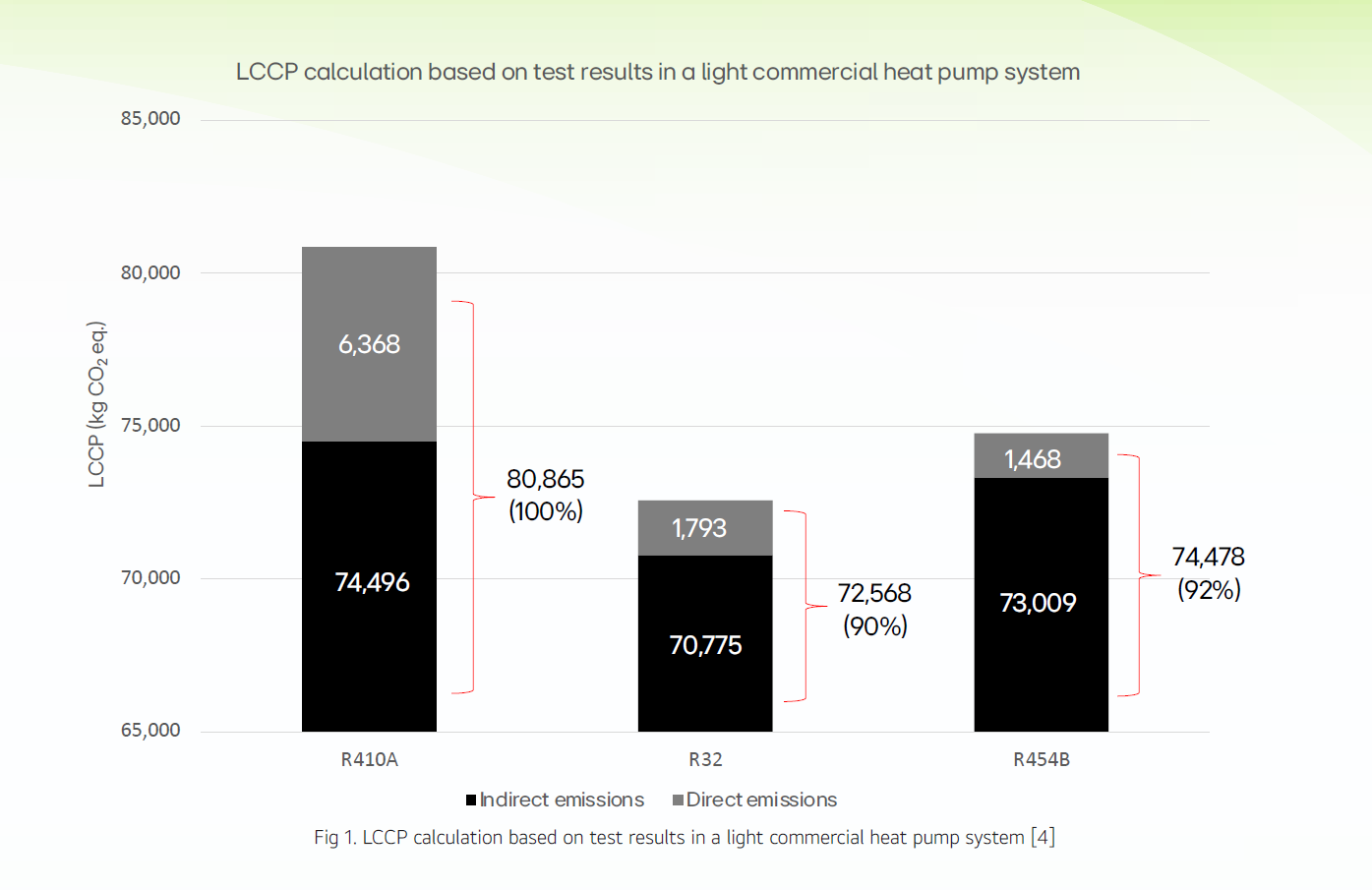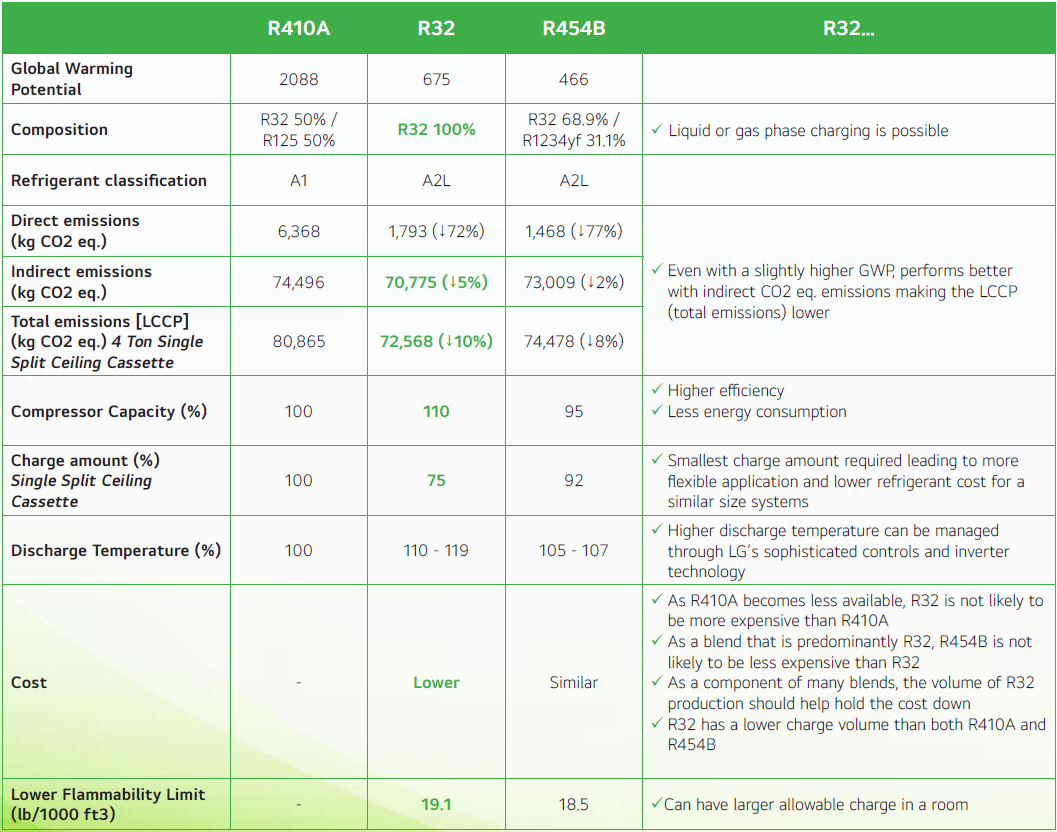Why R32
Header Slider
Why R32?
LG chose R32 as the new refrigerant for its split systems. There are various advantages of using R32 and R454B in different applications. Download the full report that shows why LG chose R32 as the future refrigerant from environment, efficiency, economy, and safety points of view.
Environment
Zero Ozone Depletion
R32 is a chlorine-free lower Global Warming Potential (GWP) fluorocarbon with an Ozone Depletion Potential
(ODP) of zero. When comparing GWP of R32 (GWP 675) to that of R410A (GWP 2088), it comes in just
under 1/3, which complies with new and coming refrigerant regulations. [1]
No PFAS
In Europe, R32 is not under regulation of per-and polyfluoroalkyl substance (PFAS) while R454B and R410A
are. A restriction of PFAS use was proposed to the European Chemicals Agency (ECHA) in early 2023, and
this proposal is currently under a six-month open consultation period. [2] HFO1234yf is one of around
10,000 PFAS chemicals included in this proposed restriction which makes up 31.1% of R454B. R32 is 100%
composed of HFC32 and is not included in this proposal.
Life Cycle Climate Performance
Life Cycle Climate Performance (LCCP) is an indicator that calculates the CO2 emissions generated
throughout the entire process from production to disposal. LCCP is comprised of direct and indirect
emissions. Direct emissions include the refrigerant leakage and atmospheric degradation of refrigerants,
and indirect emissions include the energy consumption, material/refrigerant manufacturing, and material/
refrigerant recycling. [3] As shown in the graph (Fig 1) for the LCCP calculation based on test results in a
light commercial heat pump system, the direct emissions (grey) from R454B were lower but the indirect
(black) and total emissions from R32 were lower. Less LCCP means less CO2 emissions in kg CO2 eq., which
has less impact on the environment.

Energy Efficiency
Higher capacity/efficiency
As a result of evaluating the performance of the refrigerant in the low-pressure scroll compressor, R32
increased the capacity by 4-8%, and efficiency by 0-5% compared to R410A systems. Compared to R410A, a
system with R454B resulted in a decreased capacity by 5-7% and efficiency by 2-4%. [5]
Smaller charge volume
As a result of comparing the optimal refrigerant charging amount and cooling/heating performance
evaluation with a Single Split Ceiling Cassette type product, R32 and R454B systems only required 75% and
92% respectively of the refrigerant charge amount compared to R410A.
Economy
Maintenance
Mixed refrigerants such as R410A and R454B may have different mixing ratios depending on the
temperature, possibly affecting charging. As a single component refrigerant, R32 can be charged in either
liquid or gas phase.
Safety
LG has a successful history using R32 with VRF products in other parts of the world, including Europe. LG
has also applied R32 to North American window air conditioners since 2015. Per ASHRAE Standard 34,
LG’s current refrigerant, R410A is in the refrigerant class of A1 and LG’s future refrigerant, R32, is in the
class of A2L. The refrigerant classified in class A1 are non-toxic and non-flammable and the ones classified
in class A2L are non-toxic and have lower flammability. Even with their lower flammability, A2L refrigerants
are safe and relatively easy to use provided the basic precautions are followed. Compared to most A3 class
refrigerants, A2L refrigerants need at least 1,000 times more energy to ignite. [6] In practice, the guidance
keeps refrigerant concentration well below the lower flammability limit (LFL), preventing risk of ignition.
Additionally, ASHRAE 15 has been updated to support application of A2L refrigerants providing guidance to
help apply systems safely.

Conclusion
Where it is true that the discharge temperature of R32 is 10-19% higher than that of
R410A, there are also many benefits of using R32. [5] Where some in the market have
indicated that R454B is a better choice due to the higher discharge temperature of
R32 creating challenges in equipment design, LG’s variable speed technology effectively
manages the higher discharge temperatures. With LG’s sophisticated controls and
inverter compressor design, higher discharge temperatures are effectively managed,
meaning that LG can take advantage of the many benefits of R32 where other
technologies may be more challenged.
References
[1] ACHR News (2023, May). EPA’s Proposed Refrigerant Ban Prompts HVAC Industry Response. Retrieved September 21, 2023, from achrnews.com/articles/152969-epas-proposed-refrigerant-ban-prompts-hvac-industry-response
[2] European Chemicals Agency (2023, April). ECHA publishes PFAS restriction proposal. Retrieved August 10, 2023, from echa.europa.eu/-/echa-publishes-pfas-restriction-proposal
[3] International Institute of Refrigeration (2016, January 27). Guidelines for Life Cycle Climate Performance. Retrieved August 16, 2023, from
iifiir.org/en/news/iir-working-group-publishes-guidelines-for-life-cycle-climate-performance
[4] LG Electronics (2016). Applicability Assessment of Alternative Refrigerant R-454B in Air Conditioning System. Korean Journal of Air-Conditioning
and Refrigeration Engineering. Retrieved August 22, 2023.
[5] Korea Heating Air-conditioning Refrigeration & Renewable Energy News (2022, November 20). Alternative Refrigerants for R410A. Retrieved
September 13, 2023, from kharn.kr/news/article.html?no=20911
[6] Danfoss (n.d.). A2L refrigerants in commercial refrigeration. Retrieved July 24, 2023, from https://www.danfoss.com/en/about-danfoss/our-businesses/cooling/refrigerants-and-energy-efficiency/a2l-refrigerants-in-commercial-refrigeration